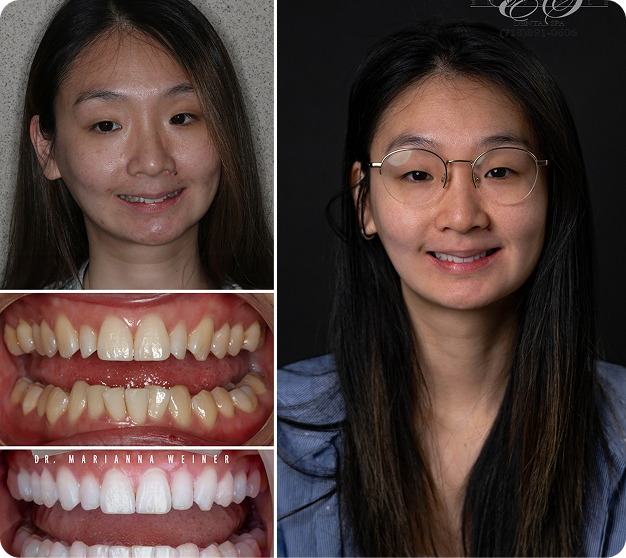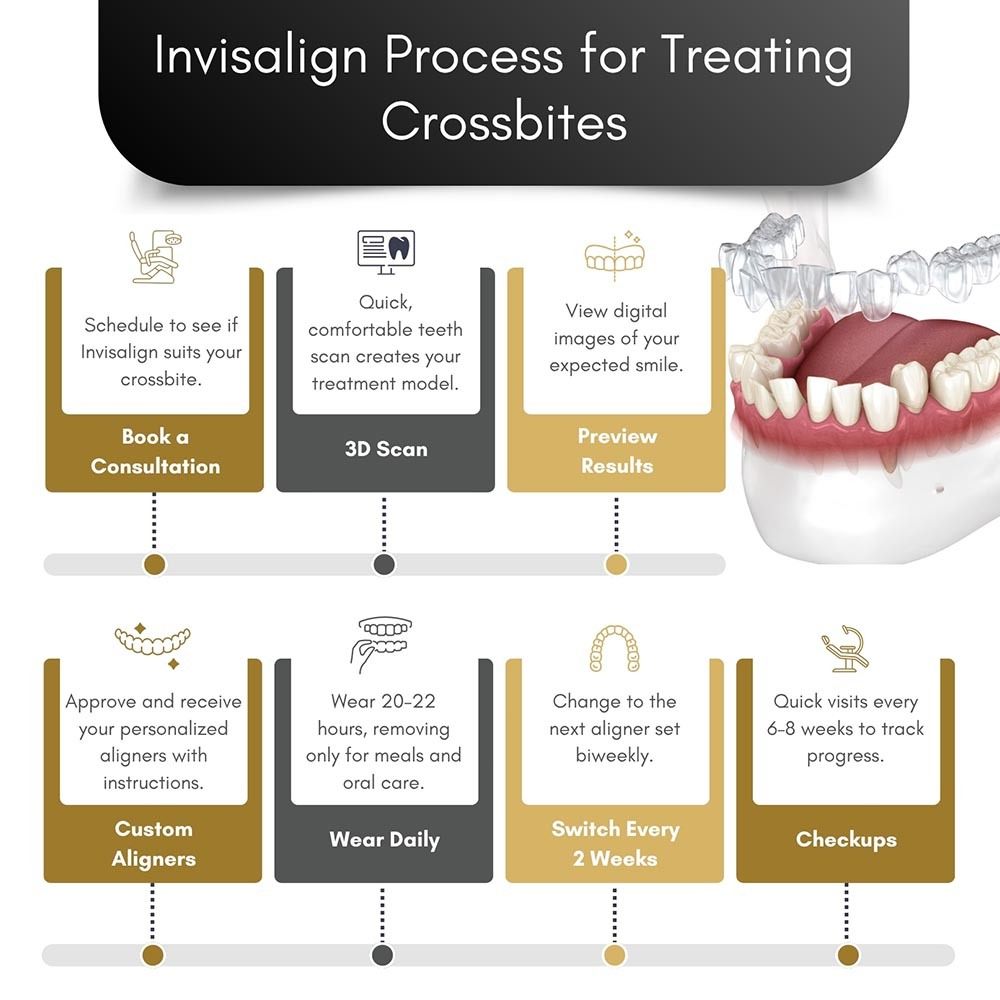What Is Invisalign?
Traditional orthodontic treatment uses fixed braces, but Invisalign is a removable aligner system. Invisalign is based on years of research and development. It produces reliable, predictable results for many orthodontic problems, including crossbites. Invisalign is popular because it is easy to use, particularly for busy adults seeking discreet orthodontic treatment.
This article examines why some people have crossbites and the potential causes. We discuss the problems that can be created if crossbites aren’t fixed. We also look at how Invisalign treatment can correct a crossbite.
What Is a Crossbite?
Very few people have perfectly aligned teeth; a crossbite refers to how teeth fit together when you close your mouth. A crossbite may affect one or both sides of your mouth, including the front teeth. When it is present, some or most of your upper teeth will bite inside your lower teeth. Ideally, your upper teeth should bite over your lower teeth.
What Causes a Crossbite?
A couple of factors can cause a crossbite, which is usually genetic. You may also have this issue if your parents or siblings have a crossbite. It is also quite possible that you will pass it on to any children you may have.
Another possible factor is circumstantial. For example, if your primary or baby teeth didn’t fall out at the correct time or if your adult teeth didn’t erupt at the right time, it could have affected the development of your jaws and remaining teeth. Consequently, you might develop a crossbite.
Other habits like thumb or finger sucking can worsen a crossbite.
Should I Fix a Crossbite?
An untreated crossbite can cause various problems, including the following.
- Tooth decay.
- Sleep apnea.
- Temporomandibular joint disorders (TMJ).
- Speech problems or difficulty forming certain sounds.
- Headaches and pain, which can affect your neck, shoulders, and jaws.
Additionally, a crossbite can affect the aesthetic appearance of your teeth.
Using Invisalign to correct these problems can improve the overall appearance of your smile.
It can also help protect your oral health so that your teeth wear down evenly, any TMJ problems are resolved, and you can enjoy better sleep quality.

How Can Invisalign Treat a Crossbite?
Invisalign can treat most types of crossbites using custom-made aligners to move your teeth into the proper positions, so they occlude or bite together properly. The aligners are comfortable and easy to wear. See other types of uneven bites which can be treated with Invisalign.
- Invisalign for Overbite
- Invisalign for Crowded Teeth
- Invisalign for Underbite
- Invisalign for Gap Teeth
- Invisalign for Open Bite
Treatment is planned precisely using digital technology. The aligners are comfortable and easy to wear.
Comparison of Invisalign and Other Orthodontic Appliances
- Invisalign vs Breezy Braces
- Invisalign vs SureSmile
- Invisalign vs Clear Braces
- Invisalign vs Traditional Braces
Patient Experience
Invisalign Process for Treating Crossbites
The process for treating a crossbite with Invisalign is outlined below.
- Schedule an appointment with our orthodontist to discover if Invisalign is the right solution to treat your crossbite. We can examine your teeth and how they meet and discuss how this treatment will work.
- The second step is to take a digital 3-D scan of your teeth. The scan creates a virtual model of your teeth that is used to plan your treatment.
- When your treatment plan is complete, you can view virtual images created by Invisalign software. These images show how your smile is predicted to look when your teeth are straightened.
- Once you are happy with the plan, we will create your custom aligners and show you how to use them.
- You must wear the aligners almost continuously and at least 20 to 22 hours daily for treatment to succeed. It’s best only to remove the aligners for meals and when brushing and flossing your teeth.
- Every 14 days, you discard your current set of aligners and begin wearing the next set. You continue to do this until your teeth are straight and treatment is complete.
- Regular checkups are needed, but only every 6 to 8 weeks. These checkups with our orthodontist at Brooklyn Invisalign Center are quick; we just need to ensure your teeth are straightening as expected.

“ Since I met them my life become more confident ✨they are really one of the best professionals in brooklyn.100% recommended for Invisalign eligners. “

Guga Tsomaia Invisalign Patient
How Long Will Treatment Take?
Your treatment time depends on the severity of the crossbite. For example, if you only have a slight crossbite, you may only need a few sets of aligners, and treatment can take as little as three months to complete. Treatment for more severe crossbites could take 18 months.
Benefits of Using Invisalign for a Crossbite
Potential benefits of choosing Invisalign to treat your crossbite include the following.
- Virtually invisible aligners. Once the aligners are in your mouth, they are almost invisible. You need to look closely to see them.
- Brushing and flossing is simple. You can brush and floss your teeth normally without using any additional tools.
- Comfortable, custom-fitted aligners. Your aligners are made from smooth plastic, so no hard edges, brackets, or wires can dig into cheeks, lips, and gums.
- Convenient treatment. Invisalign treatment has very little effect on your everyday activities. You remove the aligners for meals and oral care but must ensure you wear them at all other times.
During your initial visit, we will tell you if Invisalign is the right choice to correct your crossbite.
An added benefit is that you can view the virtual plan soon after we take your 3-D digital scan. Viewing your custom treatment plan gives you the reassurance that Invisalign will provide the desired outcome and good results.
Related Articles
- Invisalign FAQ’s
- Invisalign Alternatives
- Invisalign Candidates
- Invisalign for Front Teeth Protrusion
- Invisalign for Teenagers
- Living With Invisalign
- Invisalign Cost
- Dental Retainers
Having a crossbite can feel overwhelming, but with the right orthodontic treatment, you can straighten your teeth and a confident, healthy smile. Our orthodontist, Dr. Simons, has successfully treated many patients with malocclusion. To book an appointment, call our Invisalign dental center at (718) 375-3757.

